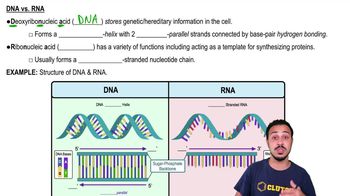Table of contents
- 1. Introduction to Biology2h 42m
- 2. Chemistry3h 40m
- 3. Water1h 26m
- 4. Biomolecules2h 23m
- 5. Cell Components2h 26m
- 6. The Membrane2h 31m
- 7. Energy and Metabolism2h 0m
- 8. Respiration2h 40m
- 9. Photosynthesis2h 49m
- 10. Cell Signaling59m
- 11. Cell Division2h 47m
- 12. Meiosis2h 0m
- 13. Mendelian Genetics4h 44m
- Introduction to Mendel's Experiments7m
- Genotype vs. Phenotype17m
- Punnett Squares13m
- Mendel's Experiments26m
- Mendel's Laws18m
- Monohybrid Crosses19m
- Test Crosses14m
- Dihybrid Crosses20m
- Punnett Square Probability26m
- Incomplete Dominance vs. Codominance20m
- Epistasis7m
- Non-Mendelian Genetics12m
- Pedigrees6m
- Autosomal Inheritance21m
- Sex-Linked Inheritance43m
- X-Inactivation9m
- 14. DNA Synthesis2h 27m
- 15. Gene Expression3h 20m
- 16. Regulation of Expression3h 31m
- Introduction to Regulation of Gene Expression13m
- Prokaryotic Gene Regulation via Operons27m
- The Lac Operon21m
- Glucose's Impact on Lac Operon25m
- The Trp Operon20m
- Review of the Lac Operon & Trp Operon11m
- Introduction to Eukaryotic Gene Regulation9m
- Eukaryotic Chromatin Modifications16m
- Eukaryotic Transcriptional Control22m
- Eukaryotic Post-Transcriptional Regulation28m
- Eukaryotic Post-Translational Regulation13m
- 17. Viruses37m
- 18. Biotechnology2h 58m
- 19. Genomics17m
- 20. Development1h 5m
- 21. Evolution3h 1m
- 22. Evolution of Populations3h 52m
- 23. Speciation1h 37m
- 24. History of Life on Earth2h 6m
- 25. Phylogeny2h 31m
- 26. Prokaryotes4h 59m
- 27. Protists1h 12m
- 28. Plants1h 22m
- 29. Fungi36m
- 30. Overview of Animals34m
- 31. Invertebrates1h 2m
- 32. Vertebrates50m
- 33. Plant Anatomy1h 3m
- 34. Vascular Plant Transport1h 2m
- 35. Soil37m
- 36. Plant Reproduction47m
- 37. Plant Sensation and Response1h 9m
- 38. Animal Form and Function1h 19m
- 39. Digestive System1h 10m
- 40. Circulatory System1h 57m
- 41. Immune System1h 12m
- 42. Osmoregulation and Excretion50m
- 43. Endocrine System1h 4m
- 44. Animal Reproduction1h 2m
- 45. Nervous System1h 55m
- 46. Sensory Systems46m
- 47. Muscle Systems23m
- 48. Ecology3h 11m
- Introduction to Ecology20m
- Biogeography14m
- Earth's Climate Patterns50m
- Introduction to Terrestrial Biomes10m
- Terrestrial Biomes: Near Equator13m
- Terrestrial Biomes: Temperate Regions10m
- Terrestrial Biomes: Northern Regions15m
- Introduction to Aquatic Biomes27m
- Freshwater Aquatic Biomes14m
- Marine Aquatic Biomes13m
- 49. Animal Behavior28m
- 50. Population Ecology3h 41m
- Introduction to Population Ecology28m
- Population Sampling Methods23m
- Life History12m
- Population Demography17m
- Factors Limiting Population Growth14m
- Introduction to Population Growth Models22m
- Linear Population Growth6m
- Exponential Population Growth29m
- Logistic Population Growth32m
- r/K Selection10m
- The Human Population22m
- 51. Community Ecology2h 46m
- Introduction to Community Ecology2m
- Introduction to Community Interactions9m
- Community Interactions: Competition (-/-)38m
- Community Interactions: Exploitation (+/-)23m
- Community Interactions: Mutualism (+/+) & Commensalism (+/0)9m
- Community Structure35m
- Community Dynamics26m
- Geographic Impact on Communities21m
- 52. Ecosystems2h 36m
- 53. Conservation Biology24m
15. Gene Expression
Introduction to Transcription
Problem 3`
Textbook Question
Transcription . a. synthesizes new daughter DNA molecules from an existing DNA molecule; b. results in the synthesis of an RNA copy of a gene; c. pairs thymines (T) with adenines (A); d. occurs on ribosomes
 Verified step by step guidance
Verified step by step guidance1
Understand the process of transcription: Transcription is the process by which a segment of DNA is used as a template to synthesize a complementary RNA molecule. This is a key step in gene expression.
Eliminate incorrect options: Option (a) describes DNA replication, not transcription. Option (c) is incorrect because transcription involves pairing adenine (A) with uracil (U) in RNA, not thymine (T). Option (d) is incorrect because transcription occurs in the nucleus (in eukaryotes), not on ribosomes.
Focus on the correct option: Option (b) is correct because transcription results in the synthesis of an RNA copy of a gene, which is complementary to the DNA template strand.
Recall the base-pairing rules in transcription: During transcription, cytosine (C) pairs with guanine (G), and adenine (A) pairs with uracil (U) in RNA.
Conclude that transcription is the process described in option (b), as it accurately reflects the synthesis of an RNA molecule from a DNA template.
 Verified video answer for a similar problem:
Verified video answer for a similar problem:This video solution was recommended by our tutors as helpful for the problem above
Video duration:
2mPlay a video:
Was this helpful?
Key Concepts
Here are the essential concepts you must grasp in order to answer the question correctly.
Transcription
Transcription is the biological process in which the information encoded in a specific segment of DNA is copied into messenger RNA (mRNA). This process is essential for gene expression, allowing the genetic code to be translated into proteins. During transcription, RNA polymerase binds to the DNA and synthesizes a complementary RNA strand, which carries the genetic information from the nucleus to the cytoplasm.
Recommended video:
Guided course

1) Initiation of Transcription
RNA vs. DNA
RNA (ribonucleic acid) and DNA (deoxyribonucleic acid) are both nucleic acids, but they have distinct structures and functions. RNA is typically single-stranded and contains uracil (U) instead of thymine (T), which is found in DNA. This difference is crucial during transcription, as RNA is synthesized based on the DNA template, resulting in an RNA copy that can be translated into proteins.
Recommended video:
Guided course

DNA vs. RNA
Role of Ribosomes
Ribosomes are cellular structures that play a critical role in translating mRNA into proteins, but they are not involved in the transcription process itself. Transcription occurs in the nucleus, where mRNA is synthesized, while ribosomes function in the cytoplasm, where they read the mRNA sequence and assemble amino acids into polypeptides. Understanding this distinction is vital for grasping the flow of genetic information in cells.
Recommended video:
Guided course

Ribosomes

 5:51m
5:51mWatch next
Master Introduction to Transcription with a bite sized video explanation from Jason
Start learningRelated Videos
Related Practice












